By the Numbers: Fernandez headlines HFX Wanderers returning full-backs
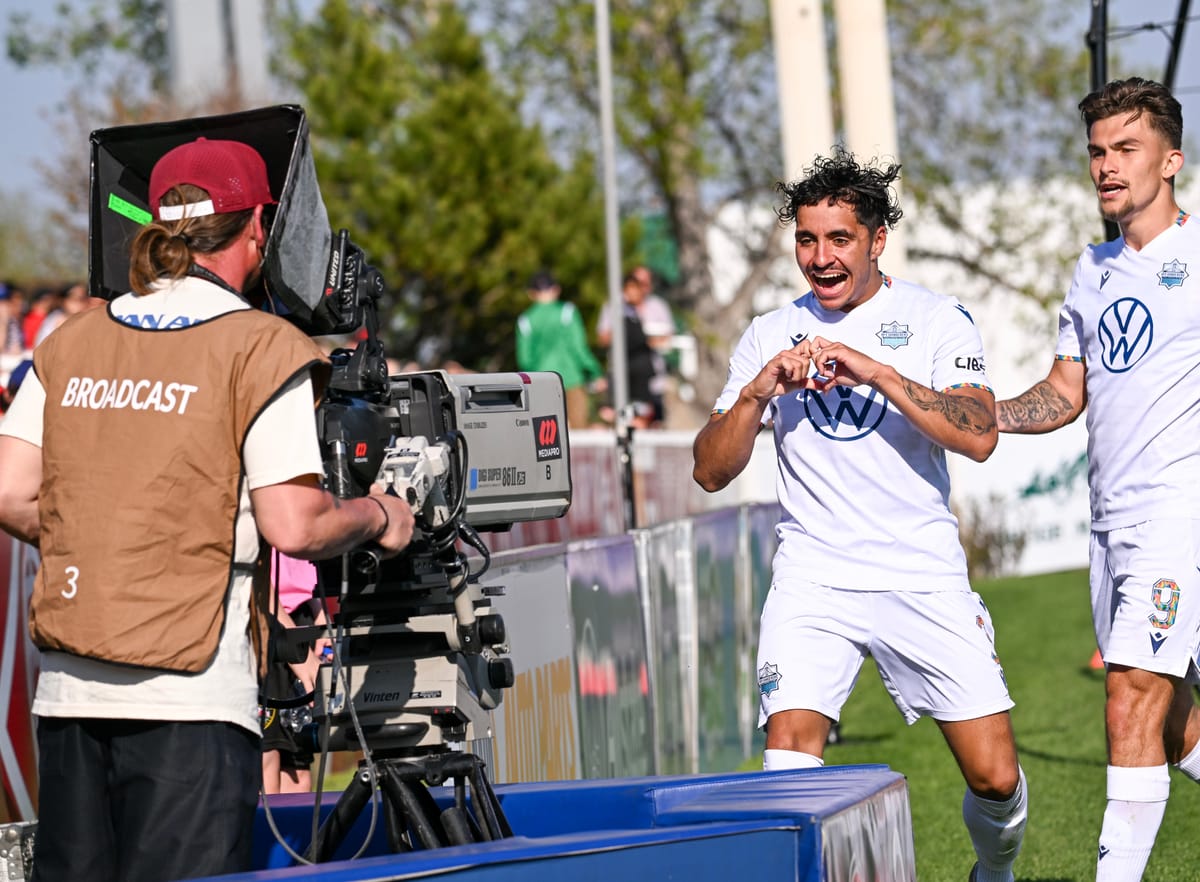
Editor's Note: This is part four of a five-part series delving into the statistical profiles of confirmed Wanderers players. Part one is available here. Part two is available here. Part three is available here.
Perhaps no position has changed more in modern football than that of the full-back.
Where once full-backs played as the deepest players, the sport has inevitably grown so that they now field duties at both ends of the pitch, patrolling their respective flanks to the ebb and flow of the game. By virtue of their contributions on both sides of the ball, full-backs need to be quick, technically sound and above all else, a cut above when it comes to football IQ so as to anticipate plays.
Modern full-backs are also more difficult to analyze from a data perspective given they are not quite attackers nor should their performances be based entirely on defensive metrics. Often, their impacts on the pitch become diluted across a slew of categories, making it a tall task to judge their effectiveness. Full-backs are cerebral by nature and it is challenging to measure things like positioning and speed — remember me mentioning the all important football IQ? — when those key decisions don't necessarily translate into ball touches or challenges.
Having said all that, the Halifax Wanderers' three returning full-backs faired relatively well last season and should provide stability on the flanks (or wherever head coach Patrice Gheisar opts to play them). With training camp now officially slated to kickoff on Feb. 21, it'll be fun to see where the trio of Zachary Fernandez, Wesley Timoteo and Riley Ferrazzo play given all of the changes this off-season.
A quick introduction to CPL By the Numbers
All of the player cards you’re about to see were created by Alex Brazier Rymek, an Ottawa-based writer who analyzes and rates CPL players through statistics. He’s been running a database recording statistics on every player in the league since 2020 and publishes his findings and comparisons on his Twitter / X account, CPL By the Numbers. He’s also a regular contributor and editor for Capital City Supporters Group.
He’s been able to create a model — sourced from his database — which compares a player’s per 90 minute actions (goal contributions, shooting, passing, etc.) relative to his peers. These categories are expressed as a percentile rank; a 50% ranking means a player is average but a 100% ranking means a player is the best in the league at that given statistic.
Group statistics are visible on the right hand side of the player cards (taken from a total of 18 individual categories) and all of this information is further distilled to produce a player’s Weighted Percentile Average or WPA on the bottom left. A 60 WPA is the typical average for any given season; 65 to 75 is considered good and over 80 is great. One thing to note is full-back WPAs are typically a bit depressed when compared to other positions due to the difficulty analyzing the data.
A more detailed description of how the model works is available here.
Player profiles
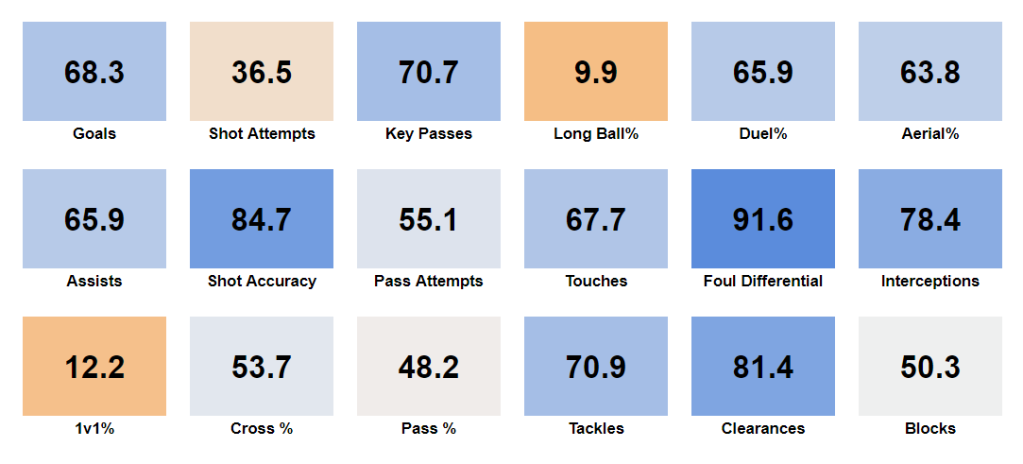
As the title to this piece suggests, 22-year old Fernandez headlines Halifax's returning full-backs.
Through 24 matches last season, Fernandez excelled in an attacking role, bombing down the right side of the pitch and generally causing havoc for opposing clubs with his devil-may-care persona. He produced several moments of excellence under Gheisar, including three goals and two assists, while drawing interest from clubs in Europe and North America. All in all, the eye test said he was one of the Wanderers' most dependable players.
Alex's model paints a similar picture but not without nuances.
Generally, Fernandez contributed across most metrics — as to be expected given his position — and earned a very respectable 66.4 WPA. His statistics are almost entirely enveloped in blue, ranking tops for tackles / interceptions (89.2%) and discipline (91.6%). His ability to contribute equally on offence is showcased by his 70.7% chance creation — meaning he's in the top third of the league for key passes to dangerous areas — and 71.7% defending grade (made up of blocks and clearances). This checks out from my coverage last year; there were multiple times where the coaching staff deliberately challenged Fernandez, either by shifting him to left-back to mark dangerous opposition or to get into the mix offensively.
The model also shows a player who fairs well in aerial battles and duels and is engaged in his club's build up. However, and this may be because of his more attacking position, Fernandez ranks poor in his general passing metrics, meaning he's taking risks to get the ball into dangerous areas. Obviously, these are risks the coaching staff want him to take. One thing that surprised me was Fernandez's low dribbling ability, especially given his highlight assist against Atlético Ottawa last year. According to the model, he consistently struggles to beat his man one-on-one (12.2%); I can't say I noticed this during matches but the numbers don't lie.
One thing not measured in Alex's model is spirit and boy, does Fernandez have that in spades. Be it training or in matches, the Québec-native is often heard challenging himself or teammates to push to the next level. No one can doubt his compete but sometimes his temper gets the best of him.
Heading into 2024, I think Fernandez is poised to have another good campaign. The only thing that worries me is the mental side: I reported that his transfer fell through earlier in the window and it can be difficult for players to re-focus. If his track record is an indicator, Fernandez will be just fine.
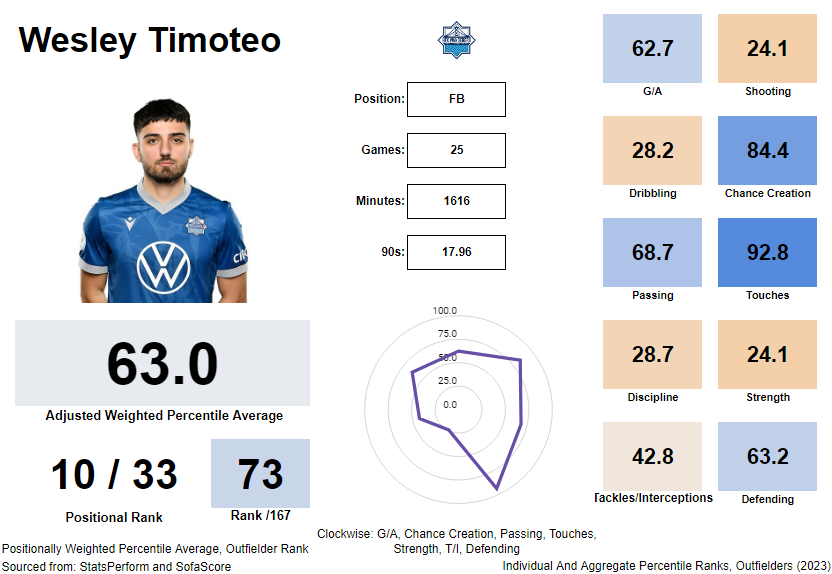
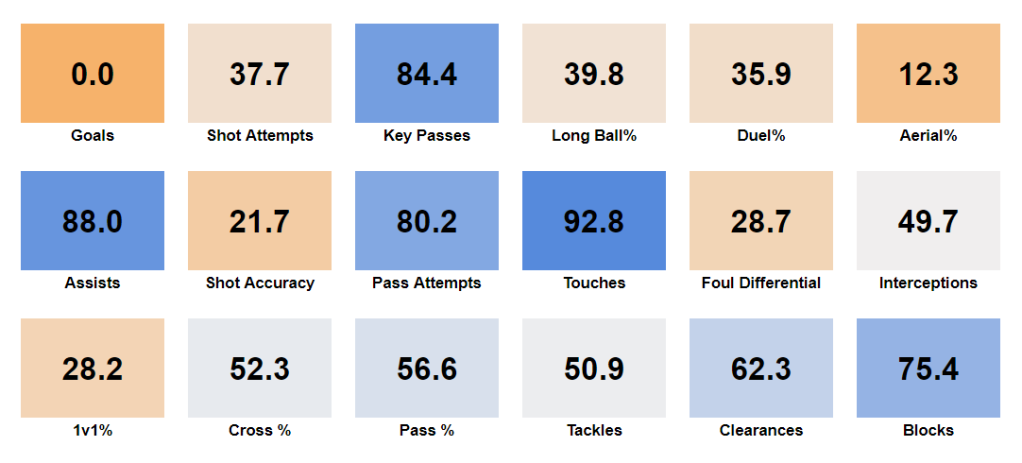
The first half of 2023 was spent trying to find Timoteo a starting role.
However, try as he might, Gheisar and his coaching staff struggled to juggle Timoteo's strengths (passing, football IQ, set-piece experience) with his weaknesses (strength and dribbling). For the first few months, the young Montréaler was destined for the bench and enjoyed mostly substitute minutes.
All of that changed on June 30: with the injury to Ryan James, Timoteo started as a left-back and ran away with the position. The 24-year old went on to feature in 24-matches and was praised up and down the Wanderers Grounds for his late year performances. His statistics, however, do show aspects of his tumultuous and multi-positional campaign.
According to Alex's model, Timoteo did three things well above average: great chance creation (84.4%), elite touches (92.8%) and overall solid passing (68.7). This may be personal preference but I for one think Timoteo is the best corner-taker the club has and multiple goals were created off his boots. He's got the ability to swing in crosses or to play line-breaking passes to teammates further upfield. His key passes (84.4%) and touches (92.%) tell the tale of a player who helps the Wanderers control the game.
But Timoteo has a similar drawback to many Wanderers; he is short (5'9) and can be taken advantage of physically. Having looked at the duel percentages and relative size of Halifax's squad last year, I have a greater admiration for James Merriman's tactics during the playoff match because it seems the Wanderers could be exploited physically. According to the model, Timoteo ranked near the bottom of the league for aerial (12.3%) and duel (35.9%) success. He also relied heavily on taking technical fouls to stop opposing players, clocking in a 28.7% foul differential. He is a gifted passer but struggled to beat his man in individual battles.
Part of me wonders where Timoteo would have landed if he had started the year at left-back but his 63 WPA ranking is nothing to sneeze at. Moving forward, it'll be integral for the Wanderers to support Timoteo with more imposing players while exploiting his set-piece and passing abilities.
Although there's still time for the Wanderers to announce new full-backs, I think it's a safe bet Timoteo will once again line up on the left side of the pitch.
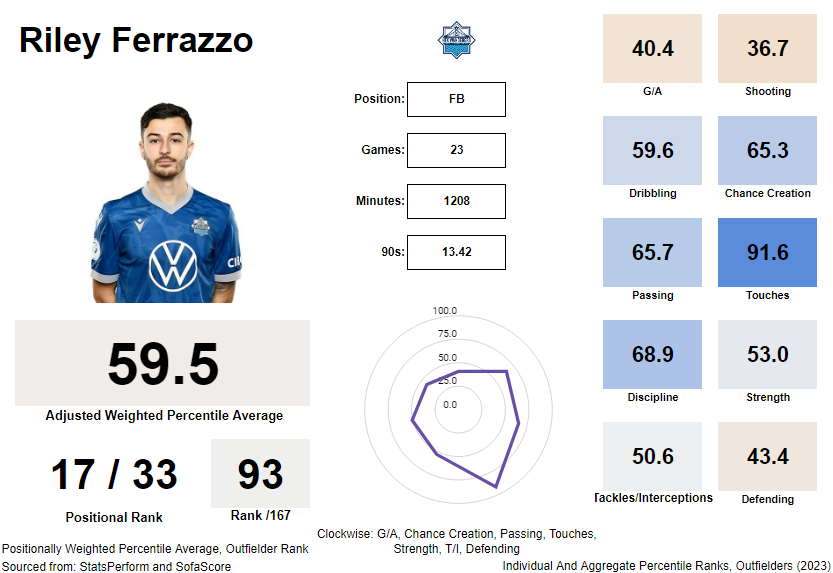
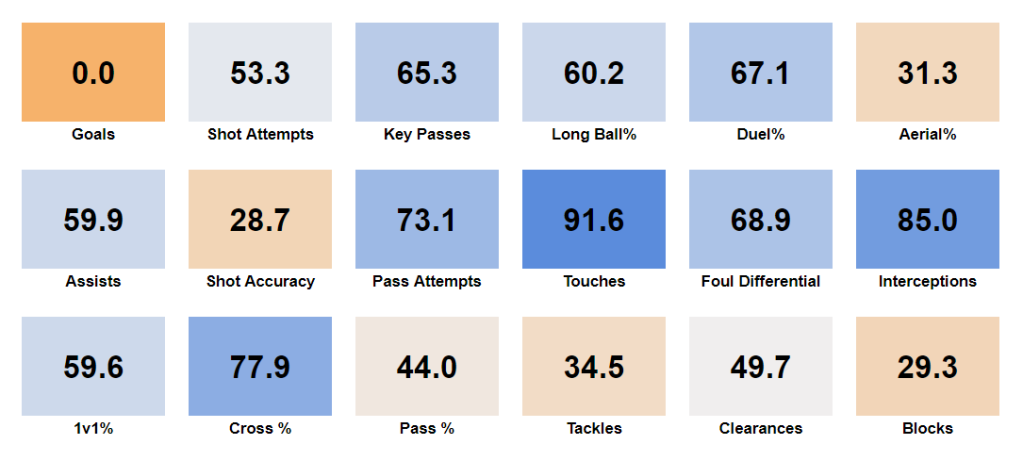
Ferrazzo — like Massimo Ferrin and Kosi Nwafornso — was one of the players Gheisar brought from Vaughan Azzurri. Player and coach have a long history together so it was no surprise the club opted to exercise Ferrazzo's option and bring him back to be, well, a bit of a jack of all trades.
Although listed as a full-back, Ferrazzo is a man who can be found all over the pitch. He started the first match last year against Atlético Ottawa as a right-back who inverts to form a double pivot. In a pinch, he'd slot in as a left-back — his typical position while at Vaughan Azzurri. As the season progressed, Ferrazzo didn't necessarily grab a starting role but he's so darn handy that he inevitably earned appearances in 23 matches. He was used a bit everywhere.
Despite his nomadic nature, Alex's model shows a player who was relatively effective in a mostly substitute role (he played 1208 minutes). Ferrazzo was exemplary when it came to touches and controlling the ball but average at most statistics. On the flip side, he was not extremely poor at anything either, making for a balanced profile.
Delving further into the numbers, Ferrazzo stood out for his high crossing marker (77.9%) and interceptions (85%). To me, the interceptions speak to his football IQ and explains why he is able to morph so easily into whatever Gheisar asks of him. The same can be said for his number of touches; he supports the ball where it needs supporting. Other than that, he rates average for key passes, long balls and duel percentages. Ferrazzo is not really statically poor at anything beyond his aerial numbers (31.3%).
Ferrazzo's WPA comes out to 59.5, ranking him the 93rd best player in the league. He is, statistically, almost exactly the average in the league and that's not a bad thing for a player who mostly came off the bench.
Looking ahead, I do worry about Ferrazzo's ability to distinguish himself. Last year may have been his first professional season but at 24-years old, you know he'll want to show his quality and earn more minutes. Given where he currently sits on the depth chart, I'm currently unsure he'll have the opportunity to supplant Fernandez or Timoteo for a starting role.
The margins, however, are not as wide as you may think.
Cover Photo Credit: Canadian Premier League



